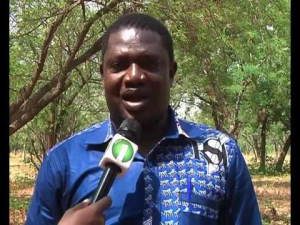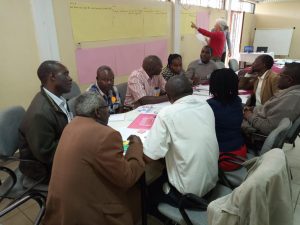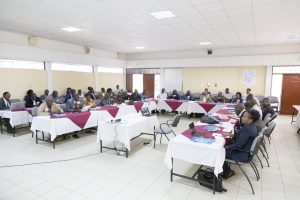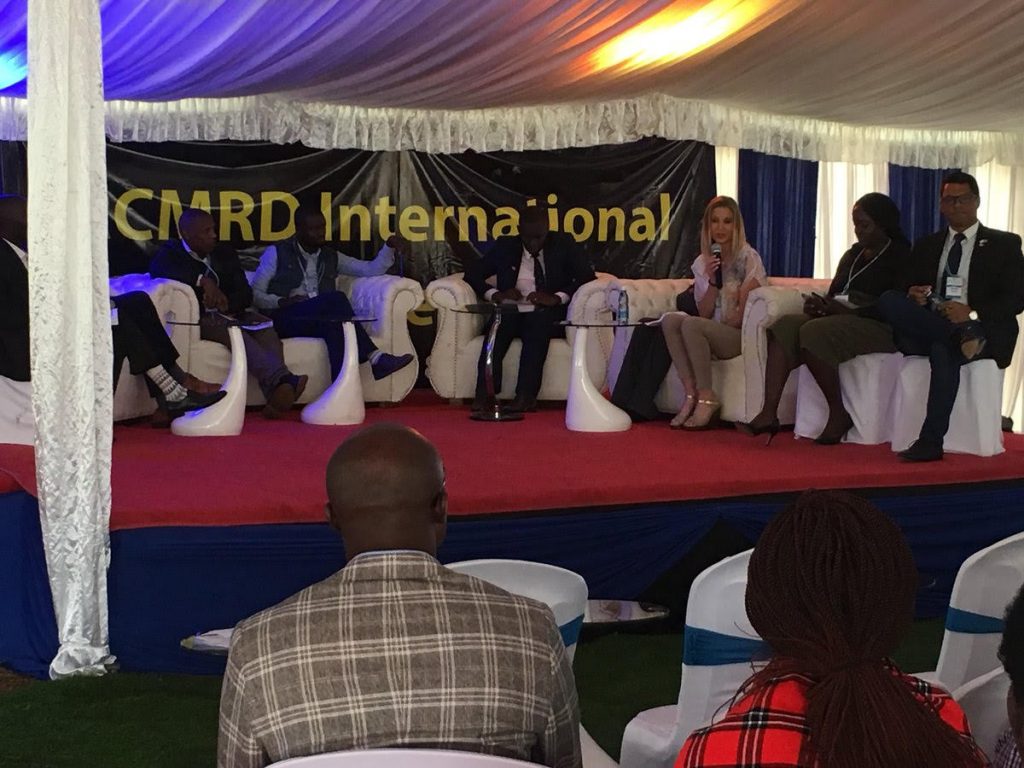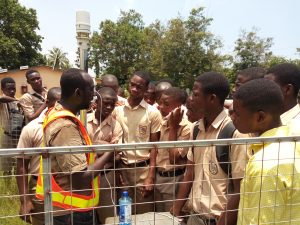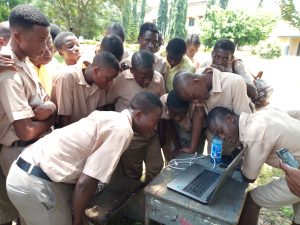photos and text: Matti Barthel (ETH Zurich, Department of Environmental Systems Science)
CBO and TAHMO cooperate in the DRC
Three years ago, we – researchers of the Congo Biogeochemistry Observatory (CBO) – got in contact with TAHMO to install weather stations at our field research sites in the Democratic Republic of Congo (DRC). Generally, basic weather data is an important pillar to conduct environmental research, which in our case mainly focuses on the biogeochemical cycling of carbon and nitrogen within the agricultural and forest systems of the Congo Basin. Until recently, the DRC was a white spot on the TAHMO network map and had, in general, poor weather station infrastructure.
Now, the data obtained from the TAHMO network provides unique, continuous, high-resolution data necessary to help unravel the complex processes of carbon and nitrogen cycling that in turn are important players in global climate through the release and uptake of greenhouse gases. Over the course of the last three years, we successfully installed nine stations, which now provide continuous data in quasi-real-time. For us as researchers, this is an invaluable source of information that is readily at hand, especially when we talk about remote locations like the DRC. These stations were installed in strategically located regions in an effort to provide a representative and accurate estimate of climatic variables for our field sites.
Weather data for soil preservation
For example, five of the stations were installed around Lake Kivu in Eastern Congo, a region world-famous for the gorilla populations roaming the opulent and steep volcanic mountains of Virunga and Kahuzi-Biéga National Parks. Of these five stations, three are maintained by the Observatoire Volcanologique de Goma (North Kivu) and two by the Université Officielle de Bukavu (South Kivu). One of the major environmental problems of the Kivu region is increased soil erosion due to human activities such as mining and agriculture. One of the most important drivers of soil erosion is precipitation, which – falling on the steep terrain with fragile soils – results in enormous amounts of sediment exported causing flash floods and a massive amount of soil loss. These land uses become particularly deleterious because of the combination of steep terrain and high levels of precipitation common in the region. The data of the stations close to Goma are therefore used by Montfort Balgawa Rukeza, a Ph.D. student at the Catholic University of Louvain, to understand the seasonal export dynamics of suspended fine sediment through rivers as a result of the increased soil erosion driven by rainfall and land use choices.
Further, two more stations were installed in the heart of the DRC, in the Tshopo province, of which one is installed at the Campus of the Université de Kisangani and the second at the former Belgian research station at Yangambi (see picture). This part of the Congo Basin probably reflects best what people imagine when thinking of the Congo: endless green, dense, impenetrable forests, interrupted only by the mighty Congo River and its tributaries.

Figure 1: Impressions from the Yangambi meteorological office: Scheme of inside the hallway with the title ‘Bilan d’energie et bilan d’eau d’une couverture vegetale’ [energy balance and water balance of a vegetation cover]; old magazine on meteorology found in the local library; Campbell-Stokes sunshine recorder; local street (from left to right).
The weather station installed in Yangambi, on the banks of the Congo River, is to me, personally, the most valuable of all currently running stations in the DRC. This has two reasons. First, the European Commission, together with the University of Ghent, is currently establishing a micrometeorological greenhouse gas flux tower in the dense and lush tropical forest surrounding Yangambi (Congoflux) to monitor energy and greenhouse gas exchange between the forest and the atmosphere. The data generated by the TAHMO Yangambi weather station will deliver important preliminary data mainly related to wind speed and direction, which can provide critical information for the setup of the tower (flux footprint).
The second reason is related to the static analog archives of past weather conditions recorded manually at Yangambi. This dataset dates back to 1905 and was maintained and assembled by the Institut National pour l’Etude Agronomique du Congo Belge (INEAC) and later continued by the Institut National des Etudes et de Recherches Agronomiques (INERA). Emmanuel Kasongo Yakusu, who is a lecturer at the Université de Kisangani and also a PhD student at the University of Ghent and the Musée Royal de L’Afrique Centrale in Belgium, went through the massive task of digitizing this huge dataset, which covers now several decades into the past. Part of his work involves analyzing the recent climate change at the local (Congolese intact forest, Yangambi) and regional scale (Congo Basin). His overarching thesis objective concerns forest management of the Congo Basin facing climate change, particularly investigating the impact on the economically valuable tree genus Entandrophragma. Since the meteorological office at Yangambi is still measuring and continuing this dataset it is now very exciting to compare their analog measurement methods, which are still the same as 100 years ago, with the recordings of our TAHMO weather station. Comparing the TAHMO station with analog measurements.
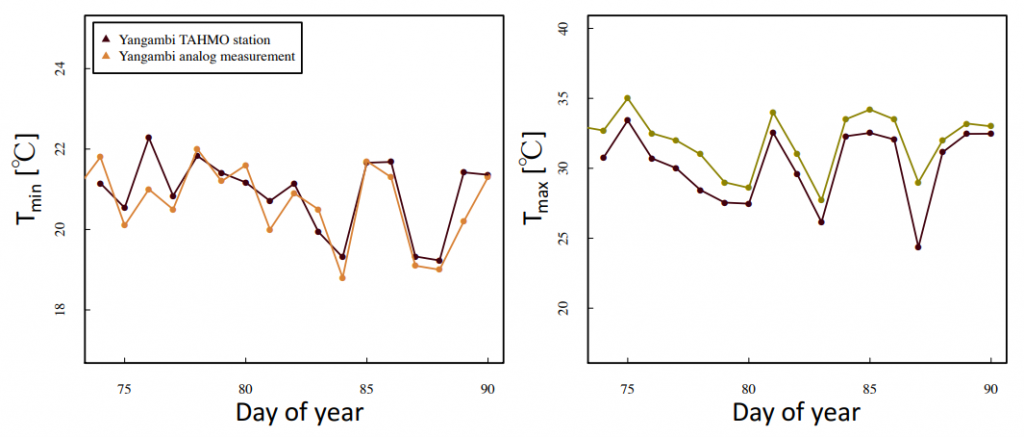
Figure 2: Two weeks of daily minimum (left panel) and maximum (right panel) temperatures recorded at Yangambi meteorological office measured with TAHMO (black) and conventional analog devices (colored).
Figure 2 shows an evaluation over two weeks of temperature data recorded with the TAHMO weather station compared to the temperature taken with the analog methods of the Yangambi meteorological office. This comparison nicely illustrates how a combination of different datasets can verify and validate the traditional measurement techniques employed at Yangambi to better explore the wealth of information hidden in this inherited treasure.
Cooperation to monitor meteorological data across the DRC.
The last two stations of our growing network were recently installed in the very south of the DRC close to the city of Lubumbashi, within a landscape dominated by enormous termite mounds scattered in between the vast Miombo woodlands. In sum, the building relationship between TAHMO and CBO has greatly improved our ability to continuously monitor meteorological data across the DRC by covering various climatic zones including montane rainforests in the east, dense lowland forests in central Congo and woodland savannah in the south. Further, it provides the lecturers at the local universities with an excellent tool for their classes in fields like hydrology, meteorology, pedology or ecology just to name a few.

